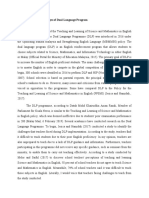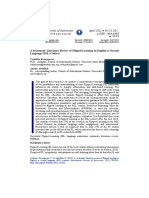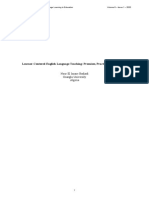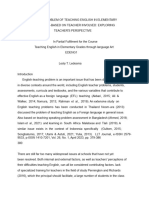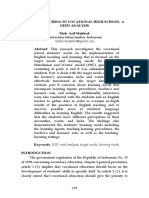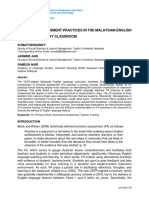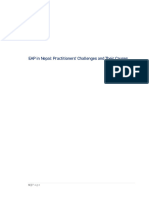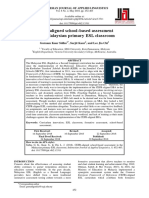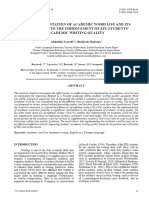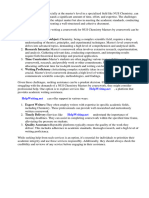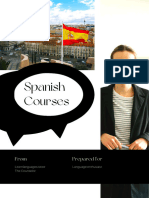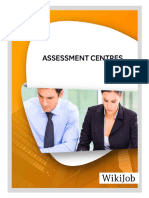Ej 1434108
Uploaded by
dianaputrialik2classEj 1434108
Uploaded by
dianaputrialik2classThe Electronic Journal for English as a Second Language
Developing EFL Teachers’ Language Assessment Literacy: A
Systematic Literature Review on Teacher Training Programs
August 2024 – Volume 28, Number 2
https://doi.org/10.55593/ej.28110a8
Indah Puspawati
Universitas Negeri Malang, Indonesia;
Universitas Muhammadiyah Yogyakarta, Indonesia
<[email protected]>
Maharani Khansa
Universitas Negeri Malang, Indonesia
<[email protected]>
Utami Widiati
Universitas Negeri Malang, Indonesia
<[email protected]>
Abstract
Teachers’ language assessment literacy (LAL) refers to teachers' ability to perform assessment-
related tasks. Despite the significant role of language assessment literacy in English language
teaching and learning, many teachers reported to have an inadequate ability to perform
assessment-related tasks because of the lack of assessment training programs that prepared
them for the tasks. This study aimed at investigating the existing assessment training programs
to develop EFL teachers’ LAL. A systematic literature review was conducted to observe trends
in how assessment training programs were carried out in the past decades. PRISMA model was
used for identifying, screening, and selecting. Twenty-eight studies published between 2012
and 2022 were reviewed. The results reveal that the assessment training models comprised
theoretical and practical components of language assessments. The results also show that the
methods for delivering the content are collaborative and reflective practices. The findings of
this study should be considered in the design of EFL teacher training programs on assessment.
Keywords: Language assessment literacy, LAL, EFL teachers, Assessment training,
Systematic literature review
Teachers should have the ability to conduct assessments in teaching and learning. For language
teachers, the term ‘Language Assessment Literacy’ (LAL) refers to language teachers' ability
to design, administer, and interpret the result of assessments (Davies, 2008; Fulcher, 2012;
Giraldo, 2020; Inbar-Lourie, 2008; Sevimel-Sahin & Subasi, 2019). Previous research revealed
TESL-EJ 28.2, August 2024 Puspawati et al. 1
that teachers' LAL impacted their teaching (Ahmadi et al., 2022; Mellati & Khademi, 2018;
Sultana, 2019). Sultana's (2019) research reported that teachers with adequate LAL knowledge
delivered better language teaching. Mellati and Khademi's (2018) research also suggests that
teachers with adequate LAL performed better in their teaching because they could consistently
evaluate their teaching through the results of assessments. Other studies indicated how teachers
with low or insufficient LAL failed to respond well to education reforms in their countries and
could not adapt their teaching and assessment practices as mandated by the reformed
curriculum (Firoozi et al., 2019; Razavipour & Rezagah, 2018). Thus, teachers' ability to
perform assessments is equally essential to teachers' ability to teach.
Despite the significant role of LAL, most studies on teacher training and professional
development programs focused on teaching methodologies (Sayyadi, 2022; Sulaiman et al.,
2021). Teachers claimed that they were more knowledgeable and confident in their teaching
skills than their assessment skills (Ahmadi & Ketabi, 2020; Bahtiar & Purnawarman, 2020;
Fitriyah et al., 2022; Latif, 2021). Moreover, many studies on teachers' LAL indicated that
teachers have inadequate LAL to perform assessment-related tasks (Bøhn & Tsagari, 2021;
Firoozi et al., 2019; Liu & Li, 2020; Ölmezer-Öztürk & Aydin, 2018; Razavipour & Rezagah,
2018; Sultana, 2019). Even if the teachers were reported to have sufficient or excellent
knowledge of LAL, they failed to transform their knowledge into assessment practices (Aria
et al., 2021; Levi & Inbar-Lourie, 2020; Öz & Attay, 2017; Zulaiha et al., 2020). This issue is
problematic since teachers' inability to assess their teaching would have detrimental effects on
their teaching, students, and, eventually, education. Thus, more attention should be given to
the development of teachers’ LAL.
Previous studies on ESL and EFL teachers' LAL revealed different results. ESL teachers have
been reported to have good LAL. They have relatively sound and clear knowledge of
assessment and its implementation (Singh, Singh, et al., 2022). ESL teachers are also reported
to be able to use multiple assessment strategies when assessing their students (López, 2023;
Singh, Muhammad, et al., 2022); therefore, they are considered more ready to adjust their
assessment practices in response to the curriculum reform in their teaching context (Joachim
& Hashim, 2021). On the other hand, studies on EFL teachers indicated that many EFL teachers
still have problems in conducting assessments due to the inadequate LAL. For example,
research by Watmani et al. (2020) reported that many EFL teachers were unfamiliar with LAL
principles, making it difficult for them to conduct assessment-related tasks in their teaching.
Latif's (2021) research also indicated that in many EFL contexts, EFL teachers' LAL is either
developing extremely slowly or failing to fulfill the required curriculum standards. EFL
teachers have also been reported to be underprepared when facing language assessment-related
tasks despite having participated in pre-service education programs (Jan-Nesar M et al., 2020).
Similarly, Vogt and Tsagari (2014) revealed that EFL teachers had low knowledge of LAL,
and they suggested that investigations on EFL teachers' LAL should be conducted.
The urgency of investigating EFL teachers’ LAL becomes more apparent when considering
the current number of EFL teachers globally. In the past two decades, we have been observing
the rise of globalization in conjunction with postcolonial trends, resulting in a profound impact
on the spread of English and English language teaching (ELT) in the world (Cameron &
Galloway, 2019), making English as an international language (EIL). In relation to the
profusion of EIL, Tajeddin and Pakzadian (2020) reported that English has been the dominant
foreign language in the institutional curricula as well as in foreign language teaching and
TESL-EJ 28.2, August 2024 Puspawati et al. 2
learning systems. Such a global status of English has brought about potential markets in various
areas such as textbook publishing and teaching professions, particularly in the Outer and
Expanding Circles, a model of diffusion of English proposed by Kachru to refer to ESL and
EFL contexts respectively (in Tajeddin & Pakzadian, 2020). EIL has then challenged the
notions of native speakerism in the developments of ELT textbooks and in the preparations of
English teachers since the concept of EIL offers possible different norms to exist for the use of
English in different varieties of world Englishes around the globe (Matsuda, 2019). In regard
to English teachers in particular, the ever-growing number of English speakers in the Outer
and Expanding Circle countries has consequently demanded more and more ESL as well as
EFL teachers. The global prevalence of students and teachers, more specifically in the
Expanding Circle, thus underscores the extensive reach and critical importance of this
demographic. When research on LAL has proven that ESL teachers performed better than EFL
teachers, implying that they are comparatively more equipped and supported, collecting
information about LAL-related professional development activities among EFL teachers might
illuminate the unique challenges EFL teachers face. This concern has inspired this systematic
literature review (SLR) on portraying how EFL teachers have been trained in developing their
LAL.
Many studies have investigated problems related to EFL teachers’ LAL and reported that
despite the important role of LAL, EFL teachers claimed the insufficiency of trainings in
language assessments for both pre-service teachers (Kremmel & Harding, 2020; Liu & Li,
2020; Ölmezer-Öztürk & Aydin, 2018; Sayyadi, 2022; Sultana, 2019) and in-service teachers
(Babaii & Asadnia, 2019; Berry et al., 2019; Bøhn & Tsagari, 2021; Giraldo, 2019; Tian et al.,
2021). Some studies showed that research projects had positive effects on the teachers’ LAL
(Baker & Riches, 2017; Giraldo & Murcia, 2019; Kremmel et al., 2018; Levi & Inbar-Lourie,
2020; Ölmezer-Öztürk, 2021; Saputra et al., 2020; Xie, 2021); however, problems related to
EFL teachers' LAL persist. A number of studies reported that training on LAL mainly discussed
concepts and theories of LAL without any practical implications for teachers’ LAL
(Bustamante, 2022; Ölmezer-Öztürk, 2021; Sayyadi, 2022; Sulaiman et al., 2021; Tian et al.,
2021). Consequently, such trainings may fail to prepare teachers to play active roles in
assessing students (Liu & Li, 2020; Ölmezer-Öztürk & Aydin, 2018; Öz & Attay, 2017;
Sayyadi, 2022; Sultana, 2019). Therefore, studies which investigate the training programs
targeting EFL teachers' LAL should be conducted.
Research that reported issues in trainings on EFL teachers' LAL mainly required the
participants to recall LAL training contents. For example, Sayyadi (2022) investigated in-
service teachers' LAL by asking the participants to recall their assessment training when they
were pre-service teachers. From the data, the researcher concluded that the assessment training
failed to improve the teachers' LAL. A study by Sultana (2019) also reported the same
phenomenon where the in-service teachers recalled their assessment training during their
undergraduate study to determine the in-service teachers' LAL without discussing the training
program model. Thus, whether the training that the teachers reported addressed their LAL was
still questionable. Therefore, as most studies recommend, the teacher training or professional
development programs should be reformed to achieve the targeted development of EFL
teachers' LAL. Based on the recommendations, this present study aimed to review empirical
studies on EFL teacher training and professional development programs aiming at developing
EFL teachers' LAL. This research employed an SLR method to analyze, synthesize, and
summarize previous published studies on training programs to develop EFL teachers’ LAL.
TESL-EJ 28.2, August 2024 Puspawati et al. 3
The results of this research can provide insights into programs to develop EFL teachers' LAL
and can be used to improve programs for developing teachers' LAL. Therefore, this research
investigated the models used in the training programs to develop EFL teachers' LAL. The study
addresses the following research questions:
1. What is the content of EFL teachers’ LAL training?
2. What are the LAL training methods?
3. What are the trends in training to develop EFL teachers’ LAL?
Method
This SLR explored the models used in assessment training programs that focus on developing
EFL teachers' LAL. This research adopted the PRISMA Group 2015 idea of Preferred
Reporting Items for Systematic Reviews and Meta-Analyses (PRISMA) for reporting our
systematic review. The review employed a comprehensive research protocol to ensure
transparency and rigor (Jesson et al., 2011; Petticrew & Roberts, 2006). Following the
protocols, we 1) defined the research question (RQ), 2) identified keywords and databases, 3)
conducted a comprehensive literature search, 4) applied exclusion and inclusion criteria, 5)
critically appraised the quality of the sources, and 6) synthesized the studies.
Identification
The researchers identified published articles documents from different databases based on three
criteria: i) LAL (mandatory), ii) teacher professional development or teacher training, and iii)
articles and proceedings. Research articles written in languages other than English were
excluded from this research. This research only covered online databases for broader coverage
and easier access to the databases. ERIC, ScienceDirect, Taylor and Francis, SAGE Journals,
ProQuest, and Springer databases were explored to find relevant studies. Based on previous
studies, LAL seems to have been discussed in the research literature between 2008 and 2009.
Hence, the analysis period was set for the last ten years.
Search String
The search string was based on contextualized keywords and contained concepts related to the
research question, including synonyms and abbreviations commonly used by researchers in
writing article titles. The definition of keywords has been calibrated based on several informal
searches to minimize the risk of omission. We restricted the query to titles and keywords to
perform the search from the databases. The terms Language Assessment Literacy and Teacher
Professional Development are included in the search since they become the focus of this
research. Boolean terms "AND" and "OR" (Gough et al., 2017) were used between the
keywords in the search string to find sufficient data about Language Assessment Literacy and
Teacher Professional Development. Thus, we used the following final search query:
("Language Assessment Literacy" OR "LAL" OR "Assessment Literacy" OR "Language
Assessment") AND ("assessment training" OR "Teacher professional development" OR
"teacher training").
The generic search string was defined, and wildcard characters were used to cover as many
variations of the terms as possible. Filters were also applied in the initial search to narrow down
the article selection and focus more on the targeted articles. Filters in the initial search were
used for a more straightforward further screening process. Filters applied were for articles
written in reviewed journals, written in English, and published between 2012 and 2022. These
TESL-EJ 28.2, August 2024 Puspawati et al. 4
filters were applied so that in the initial search, two exclusion criteria, such as articles not
written in English and articles published before 2012, were already excluded during the initial
search. Thus, the screening process can focus more on topics such as the disciplines covered
in the study. The initial search from the six databases using the keywords and the search filters
identified a total of 802 articles.
Screening Procedures
The screening procedures were done twice to obtain the final selection of the articles included
in the reviews. The first screening was done by the first and second authors on the databases
using the inclusion criteria. The first author did the first screening on Taylor & Francis, SAGE
Journals, and ProQuest databases. Meanwhile, the second author performed screening
procedures on ERIC, Science Direct, and Springer Link databases. The 802 articles were
screened by reading the titles and keywords written after the abstract to see if the articles
discussed Language Assessment Literacy, LAL, Assessment Literacy, EFL, ELT Assessments,
assessment training, and assessment professional development programs. The article abstracts
were scanned if the titles and the keywords did not give the expected information. For the initial
screening, we documented the results in a Google Spreadsheet. The initial screening using
inclusion criteria yielded 176 articles to be included in the second screening.
The first and second authors did the second screening of all 176 articles for final selection. In
this process, the first and second authors read the articles' abstracts to determine if the articles
discussed EFL/ELT assessment training models or EFL/ELT assessment professional
development programs. The first and second authors documented the second screening in a
Google Spreadsheet. To finalize the screening process, the first and second authors held a
meeting to discuss different selection decisions. The meeting resolved issues on the different
selections to finalize the selected articles. Based on the Kappa coefficient analysis, the inter-
rater reliability for the article selection was .876, which was categorized as the almost perfect
agreement between the raters (Viera & Garrett, 2005), in this case, between the first and the
second authors. Of the 176 articles, 28 articles were selected for the review. The review's main
focus would be the models used in assessment training or professional development programs
to develop EFL teachers' LAL. The article selection and the screening procedures can be seen
in Figure 1.
TESL-EJ 28.2, August 2024 Puspawati et al. 5
Figure 1. Flowchart of the Selection and Screening Procedure
The Profiles of the Selected Articles
After the final selection, this systematic literature review included 28 articles discussing
assessment training models used to develop teachers’ LAL. Figure 2 provides information on
the number of articles included per year. The figure shows that the earliest articles reviewed in
this research were published in 2013, while no article published in 2014 and 2016 was included.
Figure 2. Numbers of Articles Across Publication Years
Figure 3. The Contexts of the Research
Figure 3 presents the research contexts where the training programs were implemented. In-
service teacher context ranked the highest number (57%), and one study aimed to develop both
pre-service and in-service teachers. In addition, Table 1 below provides detailed information
on the educational contexts of teachers who participated in the studies.
TESL-EJ 28.2, August 2024 Puspawati et al. 6
Table 1. Publication and Context of the Research
In-service Pre-service In-service and Pre-service
Babaii and Asadnia (2019) Giraldo and Murcia (2018) Giraldo (2021)
Baker and Riches (2017) Giraldo and Murcia (2019)
Cinkara (2020) Ho and Yan (2021)
Cui et al. (2022) Kvasova (2022)
González (2021) Lam, (2015)
González et al., (2018) Lee et al. (2021)
Janssen (2022) Levy-Vered and Alhija, (2018)
Jeong (2013) Ölmezer-Öztürk, (2021)
Klug et al. (2018) Restrepo Bolivar (2020)
Kremmel et al. (2018) Torshizi and Bahraman, (2019)
Lan and Fan (2019) Xie (2021)
Levi and Inbar-Lourie
(2020)
Osidak et al. (2021)
Saputra et al. (2020)
Shafaghi et al. (2020)
Yeo (2021)
Figure 4. Regional Contexts of the Studies
Figure 4 shows the contexts of the research based on regions where the research participants
are from. Eight regions were recorded in the study, with the highest regions being West Asia,
South, and North American regions. However, four articles did not state where the research
participants are from.
Data Analysis
Thematic analysis was done on the 28 selected articles to find information linked to the research
questions. The selected articles were read meticulously and repetitively to see recurrent themes
TESL-EJ 28.2, August 2024 Puspawati et al. 7
and patterns, focusing on the training models reported in the article. The reports on the training
models were reduced into codes, categories, and themes to generate the review findings. The
first author completed coding, categorizing, and thematizing. The results were then verified by
the second and third authors to maintain the reliability of the coding.
Findings
Two main themes emerged from the articles after the analysis of the 28 articles. The first theme
was the training content that discusses the materials, topics, and issues covered in training. The
second theme was the methods used for delivering the training content. In terms of contents,
the training models for developing EFL teachers’ LAL included an introduction to theories of
language assessments, activities involving the practical implications of the language
assessment theories, and teachers’ involvement in developing assessments. Meanwhile, two
main methods for delivering the training content include collaborative and reflective practices.
These methods were reported in many studies included in this SLR. The summary of the
contents and methods of the training is presented in Figure 5.
Figure 5. Summary of the findings
The Contents of EFL Teachers' LAL Training
The contents of the training programs presented in the articles include theories of language
assessments, practical implications of the language assessment theories, and teachers’
involvement in developing assessments. However, the studies put different emphases on those
three contents in the training programs. For example, six studies have devoted quite a
significant portion to the discussion of language assessment theories, such as studies carried
out by Jeong (2013), Lam (2015), Baker and Riches (2017), Levy-Vered and Alhija (2018),
Ölmezer-Öztürk (2021), and Kvasova (2022). Most of the trainings were usually done for pre-
service teachers to lay a theoretical foundation for language assessment (e.g., Kvasova, 2022;
Ölmezer-Öztürk, 2021). Nine studies focused more on the practical implications of the
TESL-EJ 28.2, August 2024 Puspawati et al. 8
assessment theories (Babaii & Asadnia, 2019; Giraldo & Murcia, 2019; González, 2021;
Osidak et al., 2021; Shafaghi et al., 2020; Yeo, 2021). Ten studies devoted a more extensive
discussion on the activities involving teachers in developing language assessments (Cinkara,
2020; Cui et al., 2022; Ho & Yan, 2021; Janssen, 2022; Xie, 2021). However, the other three
studies (Klug et al., 2018; Lan & Fan, 2019; Restrepo Bolivar, 2020) did not indicate the
proportion of those three elements in the articles. The next part of the findings discusses how
each element was incorporated into the training programs will be presented.
The theories of language assessments. The studies reported some theories included in their
assessment training. The first theory presented was the principles of language assessments,
including tests or assessments validity, reliability, practicality, and authenticity (Baker &
Riches, 2017; Cui et al., 2022; Giraldo & Murcia, 2019; Kremmel et al., 2018). The second
theory also included in the training was the role of language assessment in language learning.
Studies by Levi and Inbar-Lourie (2020) and Ölmezer-Öztürk (2021) included the theory on
the role of assessment and evaluation in the learning environment. In addition, studies by Lam
(2015) and Ölmezer-Öztürk (2021) included discussions on how assessments can be used to
promote students' learning. Thus, the introduction of terms such as Assessment for Learning
was also included (Lam, 2015; Levi & Inbar-Lourie, 2020). This theory of the role of
assessments may broaden the teachers' knowledge of the uses of assessments beyond
monitoring students' achievement. The third theory of assessment discussed the types of
assessments, such as large-scale or high-stakes assessments (Cui et al., 2022; Lam, 2015) in
contrast to classroom assessments or low-stake assessments (Cui et al., 2022; Jeong, 2013; Lan
& Fan, 2019). Other types of assessments that were presented in the theory of assessment were
formative and summative assessments (Lam, 2015; Levi & Inbar-Lourie, 2020), and alternative
assessments (Babaii & Asadnia, 2019; Jeong, 2013; Ölmezer-Öztürk, 2021). The fourth theory
deals with LAL. Interestingly, although the training presented in the articles addressed teachers'
LAL, the theory of assessment literacy was not included in the training until 2021, as presented
in Ölmezer-Öztürk’s (2021) study. Assessment literacy is a new concept, but not many studies
included the concept in trainings.
The practical implications of language assessment theories. Besides the theories of
language assessments, practical implications of the theories were also used in trainings to
engage participants in activities to apply the language assessment theories into practice. The
activities were done to strengthen the participants' understanding of the theories. The
participants were involved in reflecting on their assessment practices based on the theories
taught earlier in training and critiquing and analyzing already available tests or assessments.
For example, Babaii and Asadnia (2019), after the participants had learned a language
assessment theory from reading research papers, evaluated their current assessment practices
based on the theories they had learned from the research papers. The same practice was also
reflected in the studies by Saputra et al. (2020) and Yeo (2021). The participants analyzed the
validity and reliability of assessment samples (Giraldo & Murcia, 2019). Other studies involved
the training participants in analyzing exam questions (Ölmezer-Öztürk, 2021), achievement
tests (Cui et al., 2022; Levy-Vered & Alhija, 2018), assessments for measuring writing skills
and their rubrics (González, 2021), and tests for national examinations (Baker & Riches, 2017).
Both the reflection and analysis were done after the training participants learned theories
related to the activity. For example, a study by Giraldo and Murcia (2019) required the
participants to analyze the validity and reliability of tests because they included the theory of
TESL-EJ 28.2, August 2024 Puspawati et al. 9
validity and reliability of tests. So, the participants had the background knowledge to analyze
the tests.
The teachers’ involvement in developing assessments. This course content is mostly used in
the training programs in developing EFL teachers' LAL. In this activity, the teachers involved
in the study were actively involved in developing assessments. Some training required
participants to develop assessments as part of the training activities, and the assessments were
not administered in any context (González, 2021; Jeong, 2013; Kvasova, 2022; Levy-Vered &
Alhija, 2018). Other training programs required the participants to develop assessments that
were administered to the participants' teaching context. The assessment can be in the form of
tests or performance-based assessments. Some of the training required teachers to design high-
stakes tests such as English Proficiency Tests (Ho & Yan, 2021; Kremmel & Harding, 2020),
diagnostic tests (Cui et al., 2022), and placement tests (Janssen, 2022). Other training programs
involved teachers in projects to develop classroom-based assessments, such as large-scale
quizzes for examinations (Cinkara, 2020), classroom tests (Xie, 2021), and authentic classroom
assessments (Lan & Fan, 2019; Saputra et al., 2020). As stated above, to be involved in
assessment development, the participants underwent a rigorous process starting with planning,
development, implementation, and evaluation. In the planning stage, the participants are
involved in activities such as writing test specifications and gathering test logistics such as
audio for listening tests or reading texts for reading tests (Kremmel et al., 2018) or collecting
information such as objectives of the tests (Janssen, 2022), students’ English ability and
learning progress (Xie, 2021). The development stage involved teachers drafting, reviewing,
feedbacking, editing, and revising the assessments (Ho & Yan, 2021; Janssen, 2022; Xie,
2021). Meanwhile, the implementation stage is administering the assessments to the intended
audience, such as students at secondary schools (Cinkara, 2020; Kremmel et al., 2018) and
students at universities (Cui et al., 2022; Janssen, 2022). The last process reported was
evaluation, which involved activities like reflecting on the process of the assessment
development or the developed assessments (Kremmel et al., 2018) and receiving constructive
feedback from the mentors (Xie, 2021). Although the evaluation process was written as one
stage in assessment development, only a few articles discussed how it was done in the research.
The LAL Training Methods
One important theme in the analysis is how the training content was delivered to ensure the
effectiveness of the training. The first method that was used in the assessment training was
collaborative practices, which was found in nine articles. Collaboration can be done among the
training participants (Giraldo & Murcia, 2019; Ho & Yan, 2021; Saputra et al., 2020) with
mentor teachers or training facilitators (Cinkara, 2020; Lee et al., 2021; Osidak et al., 2021;
Xie, 2021), or with assessment professionals (Baker & Riches, 2017). The collaborative
practices also involved the participants in the community of practice, such as the Professional
Learning Community (Ho & Yan, 2021; Saputra et al., 2020). The collaboration usually
happened during the participants' involvement in developing assessments when they worked
together to develop assessments or when the mentor teachers, training facilitators, or
assessment specialists gave feedback on the developed assessments during the development or
evaluation stage. This collaborative practice is essential in developing teachers' LAL since it
was used repeatedly in the articles.
The second method found in the articles reviewed was the use of reflective practices in
developing teachers' LAL training. Ten articles mentioned reflection throughout the training
TESL-EJ 28.2, August 2024 Puspawati et al. 10
process. The reflections were done in the form of journal and narrative writing (Babaii &
Asadnia, 2019; Restrepo Bolivar, 2020), reflective discussion forum (González et al., 2018),
and reflection report (Ölmezer-Öztürk, 2021). The reflections also varied in the form of
content. For example, participants can write reflections about the current assessment practices
(Babaii & Asadnia, 2019; González, 2021; Restrepo Bolivar, 2020; Saputra et al., 2020). In
other studies, participants also wrote reflections about the progress they experienced during the
training (Kvasova, 2022; Ölmezer-Öztürk, 2021; Restrepo Bolivar, 2020), or reflection on the
developed assessments and the implementation of the developed assessments (Klug et al.,
2018; Lee et al., 2021; Levi & Inbar-Lourie, 2020). The reflection was also done for
participants' future assessment practices and plans after the training program (Kvasova, 2022;
Restrepo Bolivar, 2020; Saputra et al., 2020).
The Trends in Training for Developing EFL Teachers’ LAL
This research aimed to examine the models for assessment training programs to develop EFL
teachers' LAL through an SLR involving 28 previous research articles published between 2012
and 2022. The reviews showed that there had been changes in the trends of LAL training in ten
years. The first change was the assessment types that became the focus of training. In the
studies published in 2012 – 2017, the training focused on large–scale tests, such as national
examinations. For example, a study by Lam (2015) reported a training program that focuses on
large-scale tests and theories underpinning the tests and discusses how to make use of the
assessment to improve classroom instruction. Other research by Baker and Riches (2017)
focused on developing the ability of participants to critique participants’ national examination
tests and to revise the national examination tests. Meanwhile, studies published in 2019 – 2022
focused more on classroom-based and alternative assessments than tests. For example, Lan and
Fan's (2019) research focused on classroom-based LAL, and Levi and Inbar-Lourie’s (2020)
research focused on developing participants' ability to develop performance-based assessments
and the rubrics accompanying the assessments. In addition, more and more training on
classroom-based assessment was reported (e.g., Kvasova, 2022; Lee et al., 2021). Meanwhile,
the articles published in 2018 focused on large-scale tests (e.g., Kremmel et al., 2018) and
classroom-based assessments (e.g., González et al., 2018; Levy-Vered & Alhija, 2018).
Publications in 2018 seem to have transitioned from focusing on large-scale tests to focusing
more on classroom-based assessments.
Another gradual change that can be seen from the articles reviewed was the nature of the
training participants' involvement in developing assessments. In the earlier years of
publications, the participants were developing assessments for the training only, and the
developed assessments were not used in a real teaching context (e.g., Giraldo & Murcia, 2018;
Levy-Vered & Alhija, 2018; Torshizi & Bahraman, 2019). Meanwhile, training reported in
later years involved teachers in developing assessments in their teaching context, which also
involved more complex processes such as reviewing, revising, administering, and evaluating
the developed assessments (Cinkara, 2020; Cui et al., 2022; Janssen, 2022; Xie, 2021). The
change may reflect more consideration of the participants' assessment contexts to bridge the
gap between the training and the assessment context. Thus, collaboration in developing
assessment also changes from collaboration among participants, between participants and
training facilitators, to collaboration between participants and mentor teachers who were not
training facilitators, and between participants and assessment specialists. The data showed a
more complex collaboration among stakeholders.
TESL-EJ 28.2, August 2024 Puspawati et al. 11
Discussion
This research revealed models of assessment training programs to develop EFL teachers'
assessment literacy. The models comprised the contents of the training and the methods in
which the training was conducted. This review revealed that assessment training should cover
both theoretical frameworks of assessment, including theories of principles of language
assessments that discuss the validity, reliability, authenticity, and practicality of language
assessment. The reviewed articles also discussed the theories of the roles of language
assessments in teaching, types of assessments, and assessment literacy. These theories of
language assessments can enhance teachers' knowledge of the basic principles of language
assessments, which become the foundation of teachers' sound assessment practices (Stiggins,
2014). This finding is also in line with Latif and Wasim’s (2022) research which revealed that
teachers lack knowledge of assessment concepts such as principles of language assessments
and different types of assessments. Besides, teachers' knowledge of language assessment
theories also influences their assessment practices. Therefore, assessment training should
include a theoretical basis for language assessment (Chan & Luk, 2022; Latif & Wasim, 2022).
In addition, the inclusion of LAL theories in assessment training also aligns with the suggestion
of a study by Watmani et al. (2020) that reported the lack of knowledge of assessment literacy
principles by teachers, which may hinder teachers from performing assessment-related tasks.
The following important content of assessment training reported in the articles was the practical
implication of assessment theories and the involvement in assessment development. This
training content is equally crucial to teachers' LAL because many previous studies reported
teachers’ inability to use assessment theories in their assessment practices (Gan & Lam, 2022;
Sayyadi, 2022; Watmani et al., 2020). Therefore, helping teachers to see the practical
implications of the assessment theories is essential for developing teachers' LAL. This research
finding highlights similar issues raised by Sulaiman et al. (2021), who argue that both practical
and theoretical components of language assessment need to be incorporated into assessment
training programs addressing teachers’ LAL. Even though Sulaiman et al. (2021) proposed
more emphasis on the theories of language assessment than the assessment practices, they
agreed that both practical and theoretical exposure to language assessments are essential.
Besides, some research recommended activities on helping teachers learn about the practical
implications of assessment theories, reflecting on the participants' past assessment practices,
which was also proposed by Gan and Lam (2022) to better assist the teachers toward new and
reformed assessment practices. Another activity presented in the articles was the participants’
involvement in developing assessments, which was also sought as an important activity in
assessment training to expand teachers’ LAL (Gan & Lam, 2022; Sayyadi, 2022; Stiggins,
2014). Sayyadi (2022) argued that teachers still need training that involves them in the
development of assessment. According to Stiggins (2014), equipping teachers with the skill to
develop sound assessments reduces the risk of using inappropriate assessment methods that
will give false information on students' progress and the teaching and learning process.
Another finding discussed in the reviewed articles was the training methods used to deliver the
training content. Across the 28 articles, collaborative and reflective practices were presented
as the methods used in training. Gan and Lam (2022) agree that collaboration enforces the
interaction between colleagues, trainers, mentor teachers, assessment specialists, and other
stakeholders to build a shared understanding of LAL acquisition. Bøhn and Tsagari (2021) and
Rohmah (2018) also emphasize that collaborating with multiple stakeholders, such as
TESL-EJ 28.2, August 2024 Puspawati et al. 12
colleagues, school management, students, and parents, can create fruitful assessment cultures,
which is an important dimension in teachers' LAL. Ahmadi and Ketabi (2020) also proposed
that collaboration between teachers and students is an important element of LAL development.
While collaboration with students and parents was deemed important (Ahmadi & Ketabi, 2020;
Bøhn & Tsagari, 2021), the present study did not find any information about such
collaboration. It may be worth noting that they should be included in the assessment training
discussion.
Reflective practices were also reported as a method used in assessment training in the reviewed
articles. The findings revealed that the training participants had to reflect on the assessment
and the training itself. The training participants reflected on their past assessment practices,
their developed assessments, and their future assessment practices. They also did reflections
on their progress in the training where they could share the essential knowledge and skills they
learned from the training and the plan after training related to their assessment and teaching. A
study by Tian et al. (2021) reported that through reflective practices, teachers developed more
awareness of their assessment practices to design meaningful tasks and develop effective
assessments. Gan and Lee (2016) also argued that reflection is an important tool that enables
teachers to capture their teaching experiences, including the assessment, and tap into their
needs, issues, and concerns in their teaching. This reflection is important to shape their
understanding of their practices because when they do reflections, they can express their
understanding of their teaching practices, including their assessment practices (Gan & Lee,
2016).
The last finding of this study is the trends in assessment training programs. The findings related
to the trends of the type of assessment included in the training were in line with DeLuca et al.
(2016), who argue that there is a growing emphasis on the themes of alternative assessments
instead of standardized tests. Fitriyah et al. (2022) also suggested paying more attention to
classroom-based assessment for teachers' professional development programs. Watmani et al.
(2020) also acknowledge trends from large-scale testing to smaller-scale assessment practices.
More emphasis on the classroom-based assessment was also suggested by Stiggins (2014), who
argues that teachers should be able to develop assessments that can give accurate information
about the classroom teaching and learning process, and large-scale tests cannot do that.
Meanwhile, the progression of the nature of collaboration has been discussed in Gan and Lam's
(2022) study that addresses the complexity of collaboration among stakeholders involved in
assessments.
Future Research on Developing EFL Teachers’ LAL
The study has some implications for future research on EFL teachers’ LAL. First, considering
the small number of articles related to training programs for developing teachers’ LAL, future
research on such training programs is still needed. For pre-service EFL teacher training
programs, research on the effectiveness of the existing assessment course to develop pre-
service teachers’ LAL can be conducted to evaluate the existing training. The result of the
evaluation of the assessment can be data to design more effective training programs. For in-
service EFL teachers, with the shifting trends from standardized tests to classroom-based
assessments, future research can investigate the training programs to equip these teachers for
this responsibility better. Second, since the trend of assessment training is in favor of
collaboration among parties involved in assessments, such as among trainees, trainers,
assessment practitioners, and assessment experts, research on the collaboration models that are
TESL-EJ 28.2, August 2024 Puspawati et al. 13
effective for developing EFL teachers’ LAL can be carried out to better design assessment
training.
Finally, due to the increasing trends of digital or online assessment in some educational
contexts, future research can also be devoted to investigating EFL teachers’ LAL for these
types of assessments. Research can also investigate how to train EFL teachers for these types
of assessments. The articles reviewed in the current study have not discussed digital/online
assessments. Therefore, it is worth noting that there is a wide range of topics that researchers
can explore regarding digital/online assessments.
Conclusion
This SLR investigated language assessment training models to develop EFL teachers' LAL.
Using the PRISMA Model 2015, a careful selection process involving identifying online
journal databases, determining search strings, and screening procedures was carried out to find
articles suitable for review to answer the research questions. The review included and analyzed
twenty-eight articles to find themes related to the assessment training models. The findings
revealed that assessment training targeting the development of teachers’ LAL covered both
theoretical and practical aspects of language assessment. Theoretical aspects were included to
give a basic understanding of language assessment as the foundation of teachers' assessment
practices. Theories such as principles of language assessments, the roles of assessments in
education, assessment types, and assessments literacy were introduced in training. The
practical implication of the theories was also included in the training to help training
participants apply the theories to their assessment practice. Participants were engaged in
activities such as analyzing assessments, reflecting on past assessment practices, and
developing assessments. The training was done using methods that required participants to
have hands-on experience throughout the programs. Collaboration and reflection were also
important components of assessment training. These two methods were reported to affect the
participants' LAL positively. Finally, there is also a growing trend where assessment training
programs moved towards developing teachers’ competencies in designing classroom-based
assessments.
This research offers crucial insight into the training models to improve teachers' LAL. The
training model could be implemented for both pre-service and in-service EFL teachers with a
more significant incline toward the in-service teachers. The training model can be adapted to
teacher training programs or professional development. Although courses or training on LAL
and teachers' professional development programs focusing on LAL may be less than those
programs for developing teaching competence, with the use of the appropriate model, the
training could be designed to develop EFL teachers' LAL effectively. In addition, the trends of
assessment training move toward teachers' classroom assessment practice, indicating the
importance of considering assessment context in designing assessment training. The limitation
of this research is that the source of data did not include major databases such as Scopus and
Web of Science. While the databases used for this research covered most publications in the
education field, the use of major databases may yield more articles that can be included in the
study. The number of articles included in this SLR can be considered small for SLR, which
means that the research on LAL, especially the ones focusing on training models to develop
teachers' LAL, still needs to be improved. Therefore, future research on LAL training programs
is still widely open. Future research on assessment training and its effects on teachers' LAL
can still be explored.
TESL-EJ 28.2, August 2024 Puspawati et al. 14
About the Authors
Indah Puspawati is currently a doctorate student at Department of English, Faculty of Letters,
Universitas Negeri Malang, Indonesia. She is a faculty member at the English Language
Education Department of Universitas Muhammadiyah Yogyakarta, Indonesia. Her research
interests include language assessment literacy, democratic language assessment, and student
voices in language assessments. ORCID ID: 0000-0002-9577-1320
Maharani Khansa is a doctorate student at Department of English, Faculty of Letters,
Universitas Negeri Malang, Indonesia. She is an English teacher for Junior High School
students in Batu, East Java. Her research interests include extensive reading, students and
teachers’ literacy, and reading engagement. ORCID ID: 0000-0002-9714-0012
Utami Widiati is a faculty member at Department of English, Faculty of Letters, Universitas
Negeri Malang (UM), Indonesia. She has researched and published extensively in the areas of
TEFL, curriculum and material development, SLA, and teacher professional development. She
is a pre-service and in-service teacher trainer and has written secondary school English
textbooks prescribed by the Indonesian government. Currently, she is the chief editor of
TEFLIN Journal and is the TEFLIN President, The Association for the Teaching of English as
a Foreign Language in Indonesia. ORCID ID: 0000-0002-8603-4556.
Acknowledgement
The first author would like to express her gratitude to the Center for Higher Education Funding
(BPPT) and Indonesian Endowment Fund for Education (LPDP) from the Ministry of Finance
Republic Indonesia for granting the scholarship and supporting this research.
To Cite this Article
Puspawati, I., Khansa, M., & Widiati, U. (2024). Developing EFL teachers’ language
assessment literacy: A systematic literature review on teacher training programs. English as a
Second Language Electronic Journal (TESL-EJ), 28(2). https://doi.org/10.55593/ej.28110a8
References
Ahmadi, M. R. S., & Ketabi, S. (2020). Features of language assessment literacy in Iranian
English language teachers’ perceptions and practices. Journal of Teaching Language Skills,
38(1), 191–223. https://doi.org/10.22099/jtls.2020.34843.2739
Ahmadi, S., Ghaffary, S., & Shafaghi, M. (2022). Examining teacher assessment literacy and
instructional improvement of Iranian high school teachers on various fields of study.
International Journal of Language Testing, 12(1). DOI: 10.22034/IJLT.2022.146981
Aria, D., Sukyadi, D., & Kurniawan, E. (2021). Teacher assessment literacy: Indonesian EFL
teachers’ self-perceived on classroom-based assessment practice. English Review: Journal of
English Education, 10(1). https://doi.org/10.25134/erjee.v10i1.5349
Babaii, E., & Asadnia, F. (2019). A long walk to language assessment literacy: EFL teachers’
reflection on language assessment research and practice. Reflective Practice, 20(6), 745–760.
https://doi.org/10.1080/14623943.2019.1688779
TESL-EJ 28.2, August 2024 Puspawati et al. 15
Bahtiar, I., & Purnawarman, P. (2020). Investigating English teachers’ comprehension in
Language Assessment Literacy (LAL). Advances in Social Science, Education, and
Humanities Research, 508(Icite), 303–310. https://doi.org/10.2991/assehr.k.201214.253
Baker, B. A., & Riches, C. (2017). The development of EFL examinations in Haiti:
Collaboration and language assessment literacy development. Language Testing, 1–25.
https://doi.org/10.1177/0265532217716732
Berry, V., Sheehan, S., & Munro, S. (2019). What does language assessment literacy mean to
teachers? ELT Journal, 73(2), 113–123. https://doi.org/10.1093/elt/ccy055
Bøhn, H., & Tsagari, D. (2021). Teacher educators’ conceptions of language assessment
literacy. Journal of Language Teaching and Research, 12(2), 222-233.
https://doi.org/10.17507/jltr.1202.02
Bustamante, A. (2022). Language assessment literacy of middle school English teachers in
Mexico. Languages, 7(32), 1–20. https://doi.org/10.3390/languages7010032
Cameron, A., & Galloway, N. (2019). Local thoughts on global ideas: Pre- and in-service
TESOL practitioners’ attitudes to the pedagogical implications of the globalization of
English. RELC Journal, 50(1), 149–163. https://doi.org/10.1177/0033688218822853
Chan, C. K. Y., & Luk, L. Y. Y. (2022). A four-dimensional framework for teacher
assessment literacy in holistic competencies. Assessment and Evaluation in Higher
Education, 47(5), 755–769. https://doi.org/10.1080/02602938.2021.1962806
Cinkara, E. (2020). Quiz study as a professional development activity for tertiary-level EFL
test writers. TESL-EJ, 24(3). https://tesl-ej.org/wordpress/issues/volume24/ej95/ej95a5/
Cui, Y., Liu, Y., Yu, H., & Gao, Y. (2022). Developing English teachers’ language
assessment literacy in an EAP reform context through test design: A case study. System, 109.
https://doi.org/10.1016/j.system.2022.102866
Davies, A. (2008). Textbook trends in teaching language testing. Language Testing, 25(3),
327–347. https://doi.org/10.1177/0265532208090156
DeLuca, C., LaPointe-McEwan, D., & Luhanga, U. (2016). Teacher assessment literacy: A
review of international standards and measures. Educational Assessment, Evaluation and
Accountability, 28(3), 251–272. https://doi.org/10.1007/s11092-015-9233-6
Firoozi, T., Razavipour, K., & Ahmadi, A. (2019). The language assessment literacy needs of
Iranian EFL teachers with a focus on reformed assessment policies. Language Testing in
Asia, 9(1). https://doi.org/10.1186/s40468-019-0078-7
Fitriyah, I., Masitoh, F., & Widiati, U. (2022). Classroom-based language assessment literacy
and professional development need between novice and experienced EFL teachers.
Indonesian Journal of Applied Linguistics, 12(1), 126–136.
https://doi.org/10.17509/ijal.v12i1.46539
Fulcher, G. (2012). Assessment literacy for the language classroom. Language Assessment
Quarterly, 9(2), 113–132. https://doi.org/10.1080/15434303.2011.642041
TESL-EJ 28.2, August 2024 Puspawati et al. 16
Gan, L., & Lam, R. (2022). A review on language assessment literacy: Trends, Foci, and
Contributions. Language Assessment Quarterly.
https://doi.org/10.1080/15434303.2022.2128802
Gan, Z., & Lee, F. K. J. (2016). Understanding ESL student teachers’ learning of classroom
practices in the practicum: A case study in Hong Kong. Asia-Pacific Education Researcher,
25(2), 251–266. https://doi.org/10.1007/s40299-015-0258-x
Giraldo, F. (2019). Language assessment practices and beliefs: Implications for language
assessment literacy. How, 26(1), 35–61. https://doi.org/10.19183/how.26.1.481
Giraldo, F. (2020). A post-positivist and interpretive approach to researching teachers’
language assessment literacy. Profile: Issues in Teachers’ Professional Development, 22(1),
189–200. https://doi.org/10.15446/profile.v22n1.78188
Giraldo, F. (2021). Language assessment literacy and teachers’ professional development: A
review of the literature. Profile: Issues in Teachers’ Professional Development, 23(2), 265–
279. https://doi.org/10.15446/profile.v23n2.90533
Giraldo, F., & Murcia, D. (2018). Language assessment literacy for pre-service teachers:
Course expectations from different stakeholders. Gist Education and Learning Research
Journal, 16, 56–77. https://doi.org/10.26817/16925777.425
Giraldo, F., & Murcia, D. Q. (2019). Language assessment literacy and the professional
development of pre-service language teachers. Colombian Applied Linguistics Journal, 21(2),
243–259. https://doi.org/10.14483/22487085.14514
González, E. F. (2021). The impact of assessment training on EFL writing classroom
assessment: Voices of Mexican university teachers. Profile: Issues in Teachers’ Professional
Development, 23(1), 107–124. https://doi.org/10.15446/profile.v23n1.85019
González, E. F., Alicia, N., & Lopez, V. (2018). Exploring Mexican EFL elementary school
teachers’ perceptions of online language assessment training. In Journal of Applied
Linguistics and Language Research. 5(1), 225-2241.
https://www.jallr.com/index.php/JALLR/article/view/762
Gough, D., Oliver, S., & Thomas, J. (2017). An introduction to systematic reviews (2nd
Edition). Sage Publication.
Ho, E. C., & Yan, X. (2021). Using community of practice to characterize collaborative essay
prompt writing and its role in developing language assessment literacy for pre-service
language teachers. System, 101. https://doi.org/10.1016/j.system.2021.102569
Inbar-Lourie, O. (2008). Constructing a language assessment knowledge base: A focus on
language assessment courses. Language Testing, 25(3), 385–402.
https://doi.org/10.1177/0265532208090158
Jan-Nesar M, Q., Khodabakhshzadeh, H., & Motallebzadeh, K. (2020). Assessment literacy
of Iranian EFL teachers: A review of recent studies. Journal of Asia TEFL, 17(2), 689–698.
https://doi.org/10.18823/asiatefl.2020.17.2.27.689
TESL-EJ 28.2, August 2024 Puspawati et al. 17
Janssen, G. (2022). Local placement test retrofit and building language assessment literacy
with teacher stakeholders: A case study from Colombia. Language Testing, 39(3), 377–400.
https://doi.org/10.1177/02655322221076153
Jeong, H. (2013). Defining assessment literacy: Is it different for language testers and non-
language testers? Language Testing, 30(3), 345–362.
https://doi.org/10.1177/0265532213480334
Jesson, J., Matheson, L., & Lacey, F. M. (2011). Doing your literature review: Traditional
and systematic techniques. Sage Publication.
Joachim, A. & Hashim, H. (2021) ESL teacher’s knowledge and readiness on the
implementation of School-Based Assessment (SBA) in Malaysian primary school. Creative
Education, 12, 1066-1078. doi: 10.4236/ce.2021.125079.
Klug, J., Schultes, M. T., & Spiel, C. (2018). Assessment at school – Teachers’ diary-
supported implementation of a training program. Teaching and Teacher Education, 76, 298–
308. https://doi.org/10.1016/j.tate.2017.10.014
Kremmel, B., & Harding, L. (2020). Towards a comprehensive, empirical model of language
assessment literacy across stakeholder groups: Developing the language assessment literacy
survey. Language Assessment Quarterly, 17(1), 100–120.
https://doi.org/10.1080/15434303.2019.1674855
Kremmel, B., Eberharter, K., Holzknecht, F., & Konrad, E. (2018). Fostering language
assessment literacy through teacher involvement in high-stakes language testing. In D. Xerri
& P. Vella Briffa (Eds.), Teacher involvement in high-Stakes Language Testing, (pp. 173–
194). Springer International Publishing. https://doi.org/10.1007/978-3-319-77177-9
Kvasova, O. (2022). The impact of student teachers’ pre-existing conceptions of assessment
on the development of language assessment literacy within an LTA course. Languages, 7(1).
https://doi.org/10.3390/languages7010062
Lam, R. (2015). Language assessment training in Hong Kong: Implications for language
assessment literacy. Language Testing, 32(2), 169–197.
https://doi.org/10.1177/0265532214554321
Lan, C., & Fan, S. (2019). Developing classroom-based language assessment literacy for in-
service EFL teachers: The gaps. Studies in Educational Evaluation, 61, 112–122.
https://doi.org/10.1016/j.stueduc.2019.03.003
Latif, M. W. (2021). Exploring tertiary EFL practitioners’ knowledge base component of
assessment literacy: Implications for teacher professional development. Language Testing in
Asia, 11(19), 1–22. https://doi.org/10.1186/s40468-021-00130-9
Latif, M. W., & Wasim, A. (2022). Teacher beliefs, personal theories and conceptions of
assessment literacy—a tertiary EFL perspective. Language Testing in Asia, 12(11). 022).
https://doi.org/10.1186/s40468-022-00158-5
Lee, J., Butler, Y. G., & Peng, X. (2021). Multiple stakeholder interaction to enhance pre-
service teachers’ language assessment literacy. Languages, 6(4).
https://doi.org/10.3390/languages6040213
TESL-EJ 28.2, August 2024 Puspawati et al. 18
Levi, T., & Inbar-Lourie, O. (2020). Assessment literacy or language assessment Literacy:
learning from the teachers. Language Assessment Quarterly, 17(2), 168–182.
https://doi.org/10.1080/15434303.2019.1692347
Levy-Vered, A., & Alhija, F. N. A. (2018). The power of a basic assessment course in
changing pre-service teachers’ conceptions of assessment. Studies in Educational Evaluation,
59, 84–93. https://doi.org/10.1016/j.stueduc.2018.04.003
Liu, J., & Li, X. (2020). Assessing young English learners: language assessment literacy of
Chinese primary school English teachers. International Journal of TESOL Studies, 2, 36–49.
https://www.tesolunion.org/journal/details/info/7NzIueOTcy/Assessing-Young-English-
Learners:-Language-Assessment-Literacy-of-Chinese-Primary-School-English-Teachers
López, A. A. (2023). ESL teachers’ perceptions of effective classroom assessment feedback.
Language Teaching Research Quarterly, 37, 91–107.
https://doi.org/10.32038/ltrq.2023.37.04
Matsuda, A. (2019). World Englishes in English language teaching: Kachru’s six fallacies
and the TEIL paradigm. World Englishes, 38(1–2), 144–154.
https://doi.org/10.1111/weng.12368
Mellati, M., & Khademi, M. (2018). Exploring teachers’ assessment literacy: Impact on
learners’ writing achievements and implications for teacher development. Australian Journal
of Teacher Education, 43(6), 1–18. https://doi.org/10.14221/ajte.2018v43n6.1
Ölmezer-Öztürk, E. (2021). Developing language assessment literacy of EFL pre-service
teachers through classroom assessment course. International Journal of Contemporary
Educational Research. https://doi.org/10.33200/ijcer.932721
Ölmezer-Öztürk, E., & Aydin, B. (2018). Toward measuring language teachers’ assessment
knowledge: Development and validation of language assessment knowledge scale (LAKS).
Language Testing in Asia, 8(1). https://doi.org/10.1186/s40468-018-0075-2
Osidak, V., Drahinda, O., & Kvasova, O. (2021). Training the trainers in language
assessment via mentoring: Building expertise to promote language assessment literacy of
Ukrainian university teachers. Languages, 6(194). https://doi.org/10.3390/languages6040194
Öz, S., & Attay, D. (2017). Turkish EFL instructors’ in-class language assessment literacy:
Perceptions and practices. ELT Research Journal, 6(1), 25–44.
https://dergipark.org.tr/tr/pub/eltrj/issue/28779/307996
Petticrew, M., & Roberts, H. (2006). Systematic reviews in the social sciences: A practical
guide. Blackwell Publishing.
Razavipour, K., & Rezagah, K. (2018). Language assessment in the new English curriculum
in Iran: Managerial, institutional, and professional barriers. Language Testing in Asia, 8(1).
https://doi.org/10.1186/s40468-018-0061-8
Restrepo Bolivar, E. M. (2020). Monitoring pre-service teachers’ language assessment
literacy development through journal writing. Malaysian Journal of ELT Research, 17(1),
38–52. https://meltajournals.com/index.php/majer/article/view/558
TESL-EJ 28.2, August 2024 Puspawati et al. 19
Rohmah, Z. (2018). Enhancing English teachers’ professional development: Portraying a
mentoring program. TEFLIN Journal, 29(1), 90–107.
https://doi.org/10.15639/teflinjournal.v29i1/90-107
Saputra, E. R., Hamied, F. A., & Suherdi, D. (2020). The development of beliefs and
practices of language assessment literacy: Does a professional learning community help?
Journal of Education for Teaching, 46(3), 414–416.
https://doi.org/10.1080/02607476.2020.1761250
Sayyadi, A. (2022). In-service university-level EFL instructors’ language assessment literacy
and training needs. Profile: Issues in Teachers’ Professional Development, 24(1), 77–95.
https://doi.org/10.15446/profile.v24n1.93676
Sevimel-Sahin, A., & Subasi, G. (2019). An overview of language assessment literacy
research within English language education context. Journal of Theoretical Educational
Science, 12(4), 1340–1364. https://acikerisim.aku.edu.tr/xmlui/handle/11630/9903
Shafaghi, M., Estaji, M., & Tabataba’, A. (2020). Teacher evaluation training and its effect
on EFL teacher evaluators’ perceptions and practices. MEXTESOL Journal, 44(4).
https://mextesol.net/journal/index.php?page=journal&id_article=21883
Singh, C. K. S., Muhammad, M. M., Mostafa, N. A., Yunus, M. M., Noordin, N., & Darm, R.
(2022). Exploring ESL teachers’ alternative assessment strategies and practices in the
classroom. Journal of Language and Linguistic Studies, 18(1), 411–426.
https://jlls.org/index.php/jlls/article/view/2867
Singh, C. K. S., Singh, H. K. J., Singh, T. S. M., Moneyam, S., Abdullah, N. Y., & Zaini, M.
F. (2022). ESL teachers’ assessment literacy in classroom: A review of past studies. Journal
of Language and Linguistic Studies, 18(Special issue 1), 1–17.
https://www.jlls.org/index.php/jlls/article/view/2868
Stiggins, R. (2014). Improve assessment literacy outside of schools too. The Phi Delta
Kappan, 96(2), 67–72. https://www.jstor.org/stable/24376163
Sulaiman, D., Marandi, S. S., & Tajik, L. (2021). The status quo of language assessment
literacy among Syrian EFL teachers. Applied Research on English Language, 10(2), 33–60.
https://doi.org/10.22108/are.2021.126136.1657
Sultana, N. (2019). Language assessment literacy: an uncharted area for the English language
teachers in Bangladesh. Language Testing in Asia, 9(1), 1–14.
https://doi.org/10.1186/s40468-019-0077-8
Tajeddin, Z. & Pakzadian, M. (2020). Representation of inner, outer and expanding circle
varieties and cultures in global ELT textbooks. Asian-Pacific Journal of Second and Foreign
Language Education, 5(10). https://doi.org/10.1186/s40862-020-00089-9
Tian, W., Louw, S., & Khan, M. K. (2021). COVID-19 as a critical incident: Reflection on
language assessment literacy and the need for radical changes. System, 103.
https://doi.org/10.1016/j.system.2021.102682
Torshizi, M. D., & Bahraman, M. (2019). I explain, therefore I learn: Improving students’
assessment literacy and deep learning by teaching. Studies in Educational Evaluation, 61,
66–73. https://doi.org/10.1016/j.stueduc.2019.03.002
TESL-EJ 28.2, August 2024 Puspawati et al. 20
Viera, A. J., & Garrett, J. M. (2005). Understanding interobserver agreement: The Kappa
statistic. Research Series, 37(5), 360–363. https://pubmed.ncbi.nlm.nih.gov/15883903/
Vogt, K., & Tsagari, D. (2014). Assessment literacy of foreign language teachers: Findings of
a European study. Language Assessment Quarterly, 11(4), 374–402.
https://doi.org/10.1080/15434303.2014.960046
Watmani, R., Asadollahfam, H., & Behin, B. (2020). Demystifying language assessment
literacy among high school teachers of English as a foreign language in Iran: Implications for
teacher education reforms. International Journal of Language Testing, 10(2), 129–144.
https://www.ijlt.ir/article_118025.html
Xie, Q. (2021). Developing pre-service English teachers’ assessment literacy through design-
based research. Journal of Education for Teaching, 47(3), 460–465.
https://doi.org/10.1080/02607476.2021.1906155
Yeo, M. A. (2021). “Experiencing theory first-hand was delightful and informative”:
Bridging the Theory-Practice Gap in Online Language Assessment Training. Iranian Journal
of Language Teaching Research, 9(3), 93–116. https://doi.org/10.30466/ijltr.2021.121078
Zulaiha, S., Mulyono, H., & Ambarsari, L. (2020). An investigation into EFL teachers’
assessment literacy: Indonesian teachers’ perceptions and classroom practice. European
Journal of Contemporary Education, 9(1), 189–201.
https://doi.org/10.13187/ejced.2020.1.189
Copyright of articles rests with the authors. Please cite TESL-EJ appropriately.
TESL-EJ 28.2, August 2024 Puspawati et al. 21
You might also like
- Aqa English Language Coursework Commentary Example67% (3)Aqa English Language Coursework Commentary Example8 pages
- Assessing English Language Learners Newsletter ESL 536 Week 6No ratings yetAssessing English Language Learners Newsletter ESL 536 Week 63 pages
- Portraying English Teachers' Obstacles in Applying Curriculum 2013 For High School Level in IndonesiaNo ratings yetPortraying English Teachers' Obstacles in Applying Curriculum 2013 For High School Level in Indonesia12 pages
- 2 AA literacy beliefs of Iranian EFL teachers (1)No ratings yet2 AA literacy beliefs of Iranian EFL teachers (1)19 pages
- Challenges in Implementing Extensive Reading (ER) Programs Voices From English Teachers atNo ratings yetChallenges in Implementing Extensive Reading (ER) Programs Voices From English Teachers at10 pages
- Learner-Centered Education in Language TeachingNo ratings yetLearner-Centered Education in Language Teaching21 pages
- The Perspective of English Teachers On The Implementation of The End of Academic Session Test UASA (UPDATED)No ratings yetThe Perspective of English Teachers On The Implementation of The End of Academic Session Test UASA (UPDATED)20 pages
- Zein - 2017 - Professional Development Needs of Primary EFL Teachers Perspectives of Teachers and Teacher EducatorsNo ratings yetZein - 2017 - Professional Development Needs of Primary EFL Teachers Perspectives of Teachers and Teacher Educators22 pages
- 3 Unpacking the Nexus Between Teachers' Awareness of Pragmatics Instructions and Their Classroom Practices (1)No ratings yet3 Unpacking the Nexus Between Teachers' Awareness of Pragmatics Instructions and Their Classroom Practices (1)29 pages
- English Language Curriculum Reform Strategies The Impact of EMI On Students Language ProficiencyNo ratings yetEnglish Language Curriculum Reform Strategies The Impact of EMI On Students Language Proficiency8 pages
- English Teaching in Vocational High School: A Need Analysis Moh. Arif MahbubNo ratings yetEnglish Teaching in Vocational High School: A Need Analysis Moh. Arif Mahbub30 pages
- THE_PROBLEM_OF_TEACHING_ENGLISH_IN_ELEMENTARY_SCHONo ratings yetTHE_PROBLEM_OF_TEACHING_ENGLISH_IN_ELEMENTARY_SCHO8 pages
- 13. Alharbi, 2022- CLT EFL teacher attitudesNo ratings yet13. Alharbi, 2022- CLT EFL teacher attitudes16 pages
- Formative Assessment Practices in The Malaysian English Language Primary ClassroomNo ratings yetFormative Assessment Practices in The Malaysian English Language Primary Classroom14 pages
- Teachers' Understanding of Eyl Principles and TheirNo ratings yetTeachers' Understanding of Eyl Principles and Their15 pages
- Differentiated_Instruction_for_ASD_Students_in_an_No ratings yetDifferentiated_Instruction_for_ASD_Students_in_an_17 pages
- 4.guo 2021 Formative Assessment Use in UniversNo ratings yet4.guo 2021 Formative Assessment Use in Univers18 pages
- Senior High School Students' Learning Styles: Basis For Developing and Evaluating Reading & Writing Skills Enhancement Materials For Grade 11 Food Technology Students100% (1)Senior High School Students' Learning Styles: Basis For Developing and Evaluating Reading & Writing Skills Enhancement Materials For Grade 11 Food Technology Students13 pages
- 2024-The Role of Teacher Assessment Literacy in Job Stress and Job Burnout in EFL Contexts A Mixed Methods InvestigationNo ratings yet2024-The Role of Teacher Assessment Literacy in Job Stress and Job Burnout in EFL Contexts A Mixed Methods Investigation21 pages
- The Impact of EFL Teachers' Pedagogical Beliefs and Practices: Communicative Language Teaching in A Saudi University ContextNo ratings yetThe Impact of EFL Teachers' Pedagogical Beliefs and Practices: Communicative Language Teaching in A Saudi University Context12 pages
- Exploring Self-Assessment of Speaking Skill by Efl High School StudentsNo ratings yetExploring Self-Assessment of Speaking Skill by Efl High School Students14 pages
- Translanguaing Pedagogy for EMI in Thai UniversityNo ratings yetTranslanguaing Pedagogy for EMI in Thai University17 pages
- Yohanes Christian - 20237470007 - Research Article - UPM - AWC2023No ratings yetYohanes Christian - 20237470007 - Research Article - UPM - AWC202343 pages
- International Online Journal of Education and Teaching (IOJET), 7 (2), 468-484No ratings yetInternational Online Journal of Education and Teaching (IOJET), 7 (2), 468-48418 pages
- Learning Strategies Used by The Students in Performance Assessment in EFL ClassroomNo ratings yetLearning Strategies Used by The Students in Performance Assessment in EFL Classroom14 pages
- Remedial Teaching Program For Low-Achievers: An Efl Teacher'S PerceptionNo ratings yetRemedial Teaching Program For Low-Achievers: An Efl Teacher'S Perception17 pages
- CEFR-aligned School-Based Assessment in The Malaysian Primary ESL ClassroomNo ratings yetCEFR-aligned School-Based Assessment in The Malaysian Primary ESL Classroom12 pages
- 2022 MARCH Acquisition of Teacher Assessment Literacy by Pre-Service TeachersNo ratings yet2022 MARCH Acquisition of Teacher Assessment Literacy by Pre-Service Teachers22 pages
- Challenges Faced by Teachers in Adopting Communicative Language TeachingNo ratings yetChallenges Faced by Teachers in Adopting Communicative Language Teaching14 pages
- The-Pedagogy-Of-Teaching-English-To-Young LearnersNo ratings yetThe-Pedagogy-Of-Teaching-English-To-Young Learners17 pages
- A Theoretical Review On EFL - ESL Teachers' Professional Development - Approaches, Applications, and ImpactsNo ratings yetA Theoretical Review On EFL - ESL Teachers' Professional Development - Approaches, Applications, and Impacts6 pages
- Pitikornpuangpetch, C., & Suwanarak, K. (2021) .No ratings yetPitikornpuangpetch, C., & Suwanarak, K. (2021) .27 pages
- Teachers' Academic Training For Literacy InstructionNo ratings yetTeachers' Academic Training For Literacy Instruction21 pages
- Effects of an Inclusion Professional Development Model on Inclusion Knowledge and Perceptions of Regular Middle School EducatorsFrom EverandEffects of an Inclusion Professional Development Model on Inclusion Knowledge and Perceptions of Regular Middle School EducatorsNo ratings yet
- Curriculum Planning and Instructional Design for Gifted LearnersFrom EverandCurriculum Planning and Instructional Design for Gifted LearnersNo ratings yet
- Ace Your Exams Workbook - Tertiary 2024 (SA)No ratings yetAce Your Exams Workbook - Tertiary 2024 (SA)8 pages
- Circular S7 of 2020 Revised Promotion Requirements For Grade 10-11 GuidelinesNo ratings yetCircular S7 of 2020 Revised Promotion Requirements For Grade 10-11 Guidelines114 pages
- Salesforce Non Profit Certification Dumps 2024No ratings yetSalesforce Non Profit Certification Dumps 202440 pages
- CIVIL 736 - 2023 Semester One - Course OutlineNo ratings yetCIVIL 736 - 2023 Semester One - Course Outline5 pages
- Teacher Copy - Readings in Philippine History Syllabus - AY2425No ratings yetTeacher Copy - Readings in Philippine History Syllabus - AY24259 pages
- Example Candidate Responses Paper 4 For Examination From 2020100% (1)Example Candidate Responses Paper 4 For Examination From 202025 pages




